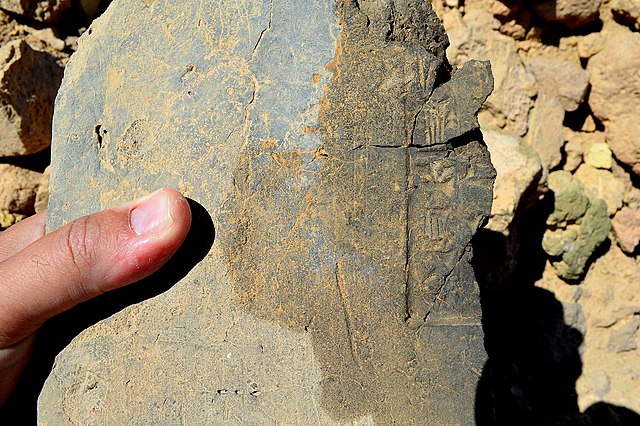Borsippa or Birs Nimrud is an archeological site in Babil Governorate, Iraq. The ziggurat is today one of the most vividly identifiable surviving ones, identified in the later Arabic culture with the Tower of Babel due to Nebuchadnezzar referring to it as the Tower of Borsippa or tongue tower, as stated in the stele recovered on site in the 19th century. However, modern scholarship concludes that the Babylonian builders of the Ziggurat in reality erected it as a religious edifice in honour of the local god Nabu, called the "son" of Babylon's Marduk, as would be appropriate for Babylon's lesser sister-city.
Ruins of the ziggurat and temple of the god Nabu at Borsippa, Babel Governorate, Iraq. 6th century BC
The original ancient gypsum plaster between mud-bricks, Borsippa, Babel, Iraq
Stamped mud-brick from the ziggurat and temple of Nabu at Borsippa, Iraq, 6th century BC
Ruins around the ziggurat and temple of the god Nabu at Borsippa, Babel Governorate, Iraq
Babylonia was an ancient Akkadian-speaking state and cultural area based in the city of Babylon in central-southern Mesopotamia. It emerged as an Akkadian populated but Amorite-ruled state c. 1894 BC. During the reign of Hammurabi and afterwards, Babylonia was retrospectively called "the country of Akkad", a deliberate archaism in reference to the previous glory of the Akkadian Empire. It was often involved in rivalry with the older ethno-linguistically related state of Assyria in the north of Mesopotamia and Elam to the east in Ancient Iran. Babylonia briefly became the major power in the region after Hammurabi created a short-lived empire, succeeding the earlier Akkadian Empire, Third Dynasty of Ur, and Old Assyrian Empire. The Babylonian Empire rapidly fell apart after the death of Hammurabi and reverted to a small kingdom centered around the city of Babylon.

Hammurabi (standing), depicted as receiving his royal insignia from Shamash (or possibly Marduk). Hammurabi holds his hands over his mouth as a sign of prayer (relief on the upper part of the stele of Hammurabi's code of laws).
Cylinder seal, ca. 18th–17th century BC. Babylonia
Prism of Sennacherib (705–681 BC), containing records of his military campaigns, culminating with Babylon's destruction. Exhibited at the Oriental Institute of the University of Chicago.
Babylonian prisoners under the surveillance of an Assyrian guard, reign of Ashurbanipal 668–630 BC, Nineveh, British Museum ME 124788








